In the Footsteps of St. Paul: A Pilgrimage...
Trace St. Paul the Apostle’s journey...
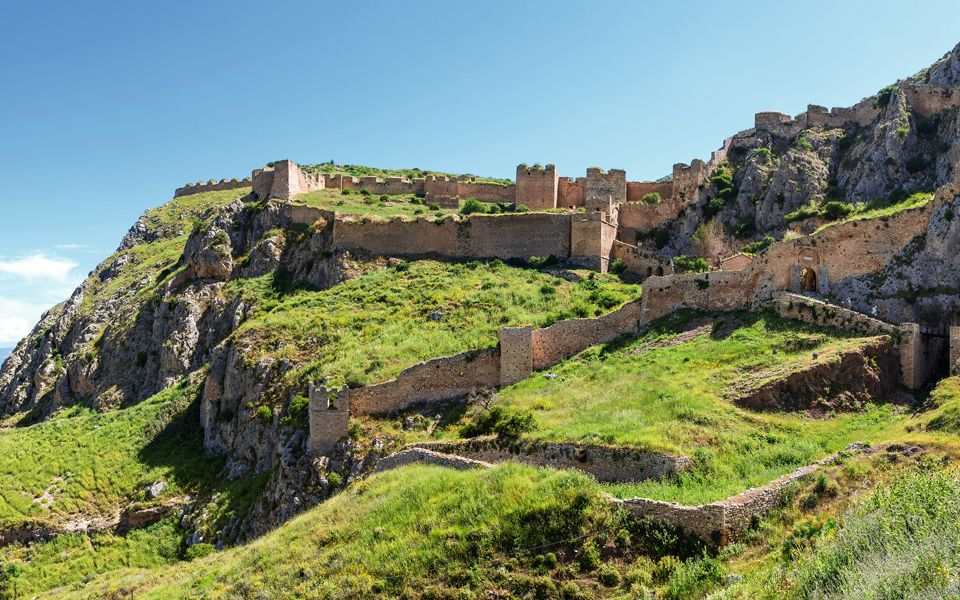
View of Acrocorinth, an extensive castle with ancient Greek, Roman, Byzantine, Frankish, Venetian and Turkish construction phases.
© Mythical Peloponnese
Nowadays often associated with the travels of Saint Paul, Corinth, with its majestic adjacent acropolis of Acrocorinth, was one of ancient Greece’s greatest cities, located at a key commercial transshipment spot and military chokepoint – the narrow isthmus connecting the Peloponnese to the rest of mainland Greece. Around 600 BC, a paved pathway, the Diolkos, was laid across the isthmus to allow ships to be easily transferred between the Saronic and Corinthian gulfs. Equipped with ports at Kenchreai and Lechaion, Corinth was a gateway and major East-West trading center that also developed a flourishing 7th- and 6th-century BC industry for the production and exportation of its own distinctive pottery.
Although occupied from Neolithic times (mid-7th millennium BC) and probably home to a Mycenaean palace during the Late Bronze Age (second half, second millennium BC), Corinth’s most visible, best-known remains date from the Archaic, Classical, Hellenistic and especially Roman periods. Always closely connected to maritime trade and the prosperity it could bring, Corinth established colonies at Kerkyra (Corfu) and Syracuse (Sicily) in the 8th century BC, which became significant trading stations and far-flung outposts of Greek culture.
“ Although occupied from Neolithic times, Corinth’s best-known remains date from the Archaic, Classical, Hellenistic and especially Roman periods. ”
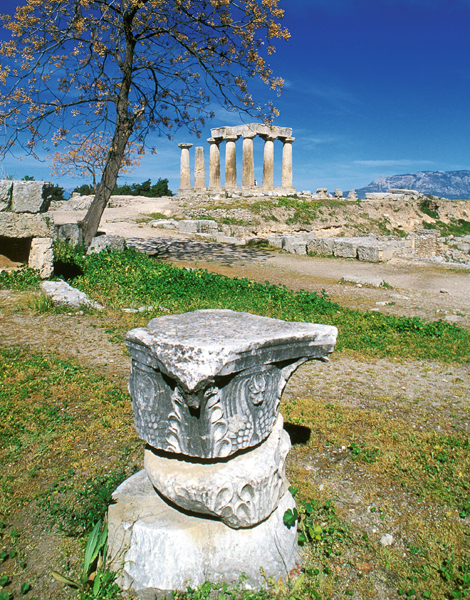
Ancient Corinth: in the foreground a finely carved Corinthian capital, with the Temple of Apollo behind.
© Clairy Moustafellou
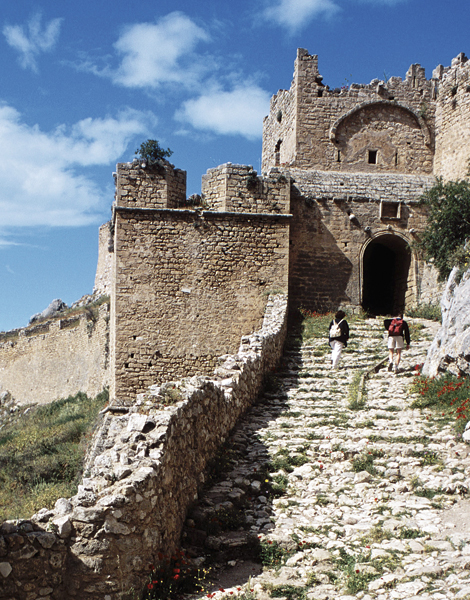
Gated entrance to the castle of Acrocorinth.
© Clairy Moustafellou
Unlike more democratic Athens, Corinth was long ruled by elite oligarchies and powerful tyrants, including Cypselus and Periander. Its troubles with Kerkyra and opposition to Athens led it to play a key role in the start of the Peloponnesian War (431-404 BC), while its strategic location and prominent involvement in this and numerous other subsequent regional struggles ultimately made Corinth a prime target for invading Romans – who burned the city to the ground in 146 BC. A century later, shortly before his assassination in 44 BC, Corinth was revived by none other than Julius Caesar, who had certain commercial and personal investment interests in the Greek East.
Corinth returned to prominence, prosperity and a life of occasionally in famous indulgence under the Romans, noted by Paul during his visits in the mid-1st century AD. Struck by severe earthquakes in later Roman times, Corinth entered centuries of alternating decline and revival, occupied successively by Byzantine imperial forces, crusading Frankish lords, Byzantines again, Ottoman Turks, Venetians and lastly Turks again, until the 1820s when the Greek Revolution finally brought independence to the Peloponnese.
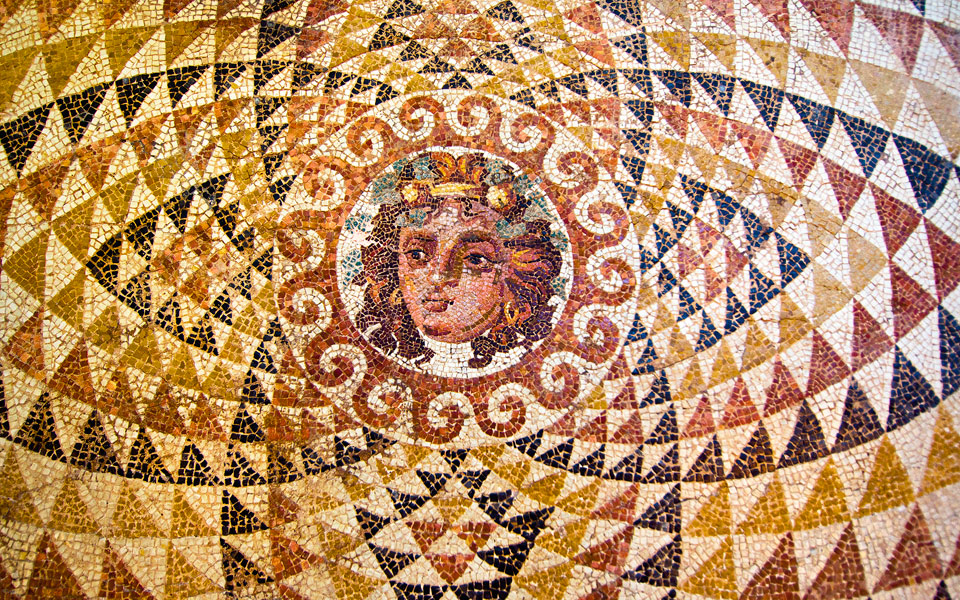
Mosaic floor with Dionysus’ head, from a Roman villa. Second half of the 2nd century AD (Archaeological Museum of Ancient Corinth).
© Clairy Moustafellou
The ruins of Ancient Corinth, covering an extensive area southwest of the modern town, include a sanctuary of Asclepius, a Greek and Roman theater, an odeon, the rock-cut Glauke Fountain and a temple dedicated to the revived city’s founding family, the gens Julia. Most prominent, however, among the remains brought to light in ongoing excavations by the American School of Classical Studies at Athens since 1896, is the Doric temple of Apollo, with its heavy, Archaic-style columns (ca. 550 BC), which overlooks the ancient city center, the agora, and a shop-lined section of the paved road leading to the Lechaion port. A second main artery would have begun on the south side of the agora, connecting the city to coastal Kenchreai, while further south on the rising slopes of Acrocorinth lay the Sanctuary of Demeter and Kore, a place of dedication and scenic ritual dining. High above, the peak’s summit – with its abundant natural spring (Upper Peirene Fountain), temple of Aphrodite, Ottoman mosques and especially its crenellated fortification walls and numerous gates – offers a bird’s-eye view of the entire surrounding landscape and an architectural panorama of the imposing defenses erected by Corinth and its successive foreign invaders.
Of particular interest for visitors today are the many structures that once adorned the heart of the city: the central marketplace or square known as the agora. Many of these now-excavated buildings have foundations, pavements and sometimes colonnaded or arched superstructures that are partly preserved and increasingly being reconstructed, conserved and made more presentable to the public. A recent focus of such works has been the area beside the museum, containing a small Frankish-era (13th century) chapel and hostel or inn that, according to Corinth Excavations Director Emeritus Charles K. Williams, once served the sick and the poor, as well as pilgrims on their way to or from the Holy Land.
“ High above, the peak’s summit offers a bird’s-eye view of the entire surrounding landscape and an architectural panorama of the imposing defenses erected by Corinth and its successive foreign invaders. ”
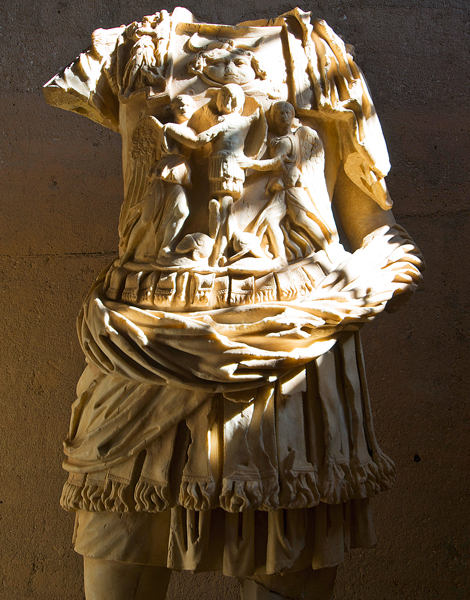
Statue of a man in armor, from the Julian Basilica, 2nd quarter of 2nd century AD (Archaeological Museum of Ancient Corinth).
© Clairy Moustafellou
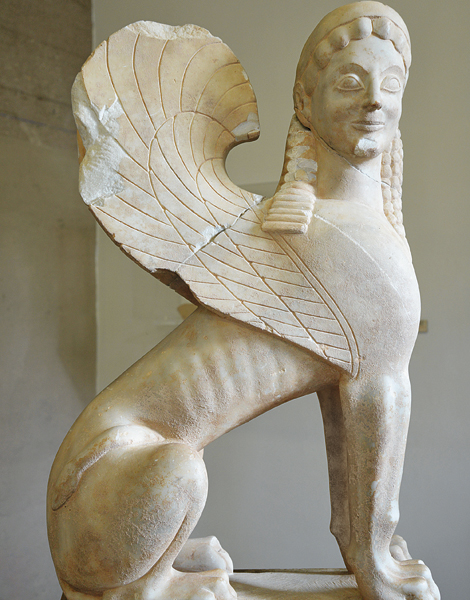
Marble sphinx (lion with bird wings, human head), from a funerary monument, resting on its haunches. Traces of decorative paint are preserved on its torso and wings. A Corinthian product, mid-6th century BC (Archaeological Museum of Ancient Corinth).
© Visualhellas.gr
On entering Corinth’s agora, one passes through a line of small temples facing onto the square, once dedicated to deities and heroes including Tyche and possibly Heracles, Poseidon, Hermes, Apollo or Aphrodite. Among these shrines was also a circular monument of eight Corinthian columns, erected by Gn. Babbius Philinus, a local official and affluent Corinthian benefactor. Flanking other sides of the agora were rows of shops in colonnaded stoas; the facade of a two-story basilica decorated on its upper level with Caryatid-like columns depicting barbarian captives; the monumental gateway (propylon) of the Lechaion road; another basilica honoring the imperial Julian family; and, along the south side, the enormous South Stoa, with more shops, the Bouleuterion (Council House), the gateway to Kenchreai and a third large basilica.
Two especially noteworthy Corinthian monuments are the tribunes’ Bema in the central area of the agora, where Paul stood in judgment, and the (lower) Peirene Fountain, a six-arched public well house with grotto-like reservoirs and a three-apsed forecourt, magnificently refurbished by Athens’ Herodes Atticus, which marked the terminus of one of Corinth’s most important watercourses. The legends associated with this fountain – reputedly named after a mournful woman transformed into a spring, dedicated to the Muses and frequented by Pegasus – along with the city’s numerous other springs, including the newly discovered (2012) Fountain of the Lamps, remind us of well-watered Corinth’s abundant natural advantages and of the ancient Peloponnese’s ubiquitous mythological traditions.
ARCHAEΟLOGICAL MUSEUM AND SITE OF ANCIENT CORINTH
Tel.: (+30) 27410.312.07
The archaeological site is open daily from 08:30 to 15:30 and entrance is free of charge
Entry to the museum costs €4 and includes admittance to the archaeological site of Ancient Corinth
Trace St. Paul the Apostle’s journey...
Antiques expert and collector Dimitris Xanthoulis...